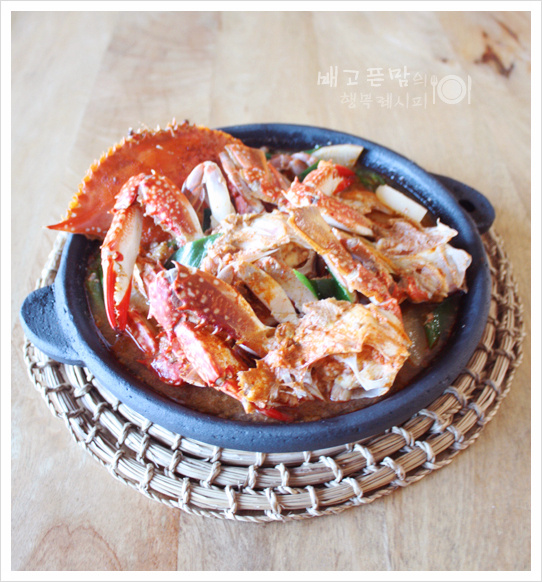Spicy and Refreshing Snow Crab Stew (Kkotgetang) Recipe
How to Prepare Snow Crabs, Delicious Snow Crab Stew Recipe, and Spicy Soup

I ordered fresh, seasonal snow crabs online for the first time. To my delight, they arrived large and plump, exceeding my expectations! I immediately prepared them and made this Kkotgetang (snow crab stew), which turned out incredibly delicious with a wonderfully refreshing broth. No special seasonings were added; the exquisite flavor comes entirely from the fresh, seasonal crabs. This recipe proves that the key to delicious food lies in the quality of fresh, seasonal ingredients. If you’re craving a deeply flavorful and clean-tasting crab stew at home, follow this guide!
Kkotgetang Ingredients- 1kg fresh seasonal snow crabs (approx. 4 crabs)
- 3 slices of Korean radish (daikon), cut into 0.5cm thick rounds
- 2 Tbsp gochugaru (Korean chili powder)
- 1 Tbsp doenjang (fermented soybean paste)
- 6 cups anchovy-and-kelp broth (approx. 1.2L)
- 1 Tbsp fish sauce (kanari aekjeot)
- 1 stalk of green onion (white and green parts separated)
- 1 Tbsp minced garlic
- 2 Korean green chili peppers
Cooking Instructions
Step 1
For this Kkotgetang, I ordered 1kg of fresh, seasonal snow crabs online. I usually enjoy the smaller crabs from the East Sea, but this time, I decided to try the plump crabs from the West Sea for the first time. Since they are in season, I’m really looking forward to their taste!

Step 2
It’s time to wash the snow crabs thoroughly under running water. Use a scrub brush to gently clean the shell, the areas between the legs, and the underside. Scrubbing diligently with a brush helps remove any debris or impurities.

Step 3
After washing, drain the snow crabs in a colander. The preparation method for crabs can vary depending on the dish. If you were making steamed crabs (Kkotgejjim), you would carefully remove the ‘poop sack’ (innards) from the underside flap using a paper towel. However, since we’re making stew (Kkotgetang), grasp the abdominal flap and carefully lift off the top shell. As you remove the top shell, gently tilt the crab to drain any innards without spilling them. Next, using scissors or a knife, remove the feathery gills. Trim the hard tip of each leg and the ragged mouthparts. Finally, cut the crab body in half crosswise. This completes the preparation for Kkotgetang. (Tip: Handle sharp tools carefully during crab preparation to avoid injury.)

Step 4
Slice the Korean radish (daikon) into approximately 0.5cm thick rounds, then cut each round into 9 bite-sized pieces. These will be placed at the bottom of the pot.

Step 5
Now, let’s prepare the base for the stew’s broth. Place the prepared radish slices in the pot. Add 2 tablespoons of gochugaru (chili powder) and 1 tablespoon of doenjang (soybean paste). Pour in 6 cups (about 1.2L) of broth made from anchovies and kelp. (Tip: If you don’t have homemade broth, you can use store-bought broth or plain water.)

Step 6
Stir everything together evenly with a spoon until the seasonings are well combined. Then, place the pot on the stove over high heat and bring it to a boil.

Step 7
Once the broth is boiling vigorously all over, add all the prepared snow crabs to the pot. These seasonal crabs look so vibrant and full of meat, they’re making me hungry just by looking at them!

Step 8
After adding the crabs, continue to boil over high heat until the broth comes to a rolling boil again. Once it’s boiling, reduce the heat to medium and let it simmer for about 10 minutes, allowing the crabs and radish to become tender and the flavors to meld. (Tip: Skimming off any foam that rises to the surface will result in a clearer broth.)

Step 9
Once the crabs have cooked a bit, add 1 tablespoon of fish sauce (kanari aekjeot) for added umami. Next, add 1 tablespoon of minced garlic. Also, add the white parts of the green onion, sliced diagonally, and let it simmer. The addition of fish sauce and garlic deepens the broth’s flavor profile.

Step 10
Finally, add the green parts of the green onion, sliced diagonally, and the 2 Korean green chili peppers, also sliced diagonally, for a touch of heat. Simmer for a moment longer after adding these final ingredients, and your refreshing and spicy Kkotgetang will be complete! It’s best enjoyed piping hot.



